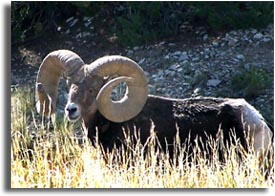|
 Majestic
Ram Dies of Natural Causes Majestic
Ram Dies of Natural Causes
A world-class bighorn sheep ram that lived along the Arkansas River was
found dead in late November. Over the past few years, the ram was spotted
in a small herd of sheep that lived on private property west of Pueblo
Reservoir.
Colorado Division of Wildlife (DOW) biologists estimate the ram was between
12 and 13 years old and was driven from the herd by younger males. At that
point, he traveled north onto property owned by Fort Carson where it died
of old age. A necropsy indicated heart and lung problems along with
arthritis and a chest infection.
“This old guy is one for the record books,” said Allen Vitt, a terrestrial
biologist from Pueblo. “Based on the initial measurements, the ram will
score among the largest in the world.” |
The current Boone & Crocket world record ram is 208 and three-eighths.
Scoring is done by taking a series of standardized measurements. Boone &
Crocket requires that horns dry for at least 60 days before measuring, so a
final score will not be calculated until February.
One thing that might prevent this sheep from becoming a new world record is
that fact that one of its horns was broken off at the tip. “Brooming” is
the name for the chipping and fraying of the horns. It is usually caused by
fighting.
Regardless of the final score, the ram was one of the most majestic bighorn
sheep recorded in Colorado.
One of the reasons this ram’s horns grew to such massive proportions is
because he lived a long time in relative seclusion. There is no public
access to the portion of the Arkansas River where it lived. The rocky
cliffs adjacent to the river provided ample protection from predators and
there was good access to forage and water.
Fort Carson military and wildlife officials discovered the ram on the
southern end of their property in late August and kept a close eye on it to
ensure its safety. The ram was showing signs of old age including decreased
muscle mass, fatigue, and had become seemingly unafraid of humans. “We were
very fortunate that personnel at Fort Carson found the ram,” said Shaun
Deeney, an area wildlife manager from Colorado Springs. “Due to their
vigilance, we will be able to preserve this majestic animal for future
generations.” The DOW plans to have the ram mounted to use in an
educational display.
“Our records indicate that bighorn sheep were first documented along the
Arkansas River between Pueblo and Cañon City in the early 1990’s, said Bob
Davies, a senior biologist with the DOW. “We believe the sheep migrated
into the rugged cliffs along the river after transplant operations along
Hardscrabble Creek in 1988.”
Bighorn sheep are the official state mammal in Colorado. They are an
extremely popular animal both for hunting and for wildlife viewing. Many
areas of the state have developed wildlife viewing areas specifically for
bighorns including Georgetown west of Denver and along the Arkansas River
west of Cañon City. |
At the time of the arrival of
European settlers, bighorn sheep were very common throughout Colorado and
the Rocky Mountain West. By the end of the 19th century, however,
populations of bighorn sheep declined.
Although the exact cause of the decline is not fully understood, wildlife
biologists believe that parasites and diseases, such as lungworm and
pneumonia, may have been key factors. Other reasons included market-hunting
to feed a growing population in the gold mining camps.
Over the past 50 years, the Colorado DOW has taken a proactive role in
sheep management and today there are approximately 8,000 sheep roaming the
mountainsides and canyon lands in the state. “Intensive management efforts
began in the 1970”s and bighorn sheep populations have been on the rise
ever since,” said Davies.
In 1962, there were at least 52 known herds of bighorn sheep in Colorado
ranging from the Continental Divide to Mesa Verde National Park. Today the
number of herds in Colorado has more than doubled. |